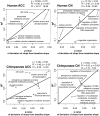Evolutionary Divergence of Gene and Protein Expression in the Brains of Humans and Chimpanzees
- PMID: 26163674
- PMCID: PMC4558850
- DOI: 10.1093/gbe/evv132
Evolutionary Divergence of Gene and Protein Expression in the Brains of Humans and Chimpanzees
Abstract
Although transcriptomic profiling has become the standard approach for exploring molecular differences in the primate brain, very little is known about how the expression levels of gene transcripts relate to downstream protein abundance. Moreover, it is unknown whether the relationship changes depending on the brain region or species under investigation. We performed high-throughput transcriptomic (RNA-Seq) and proteomic (liquid chromatography coupled with tandem mass spectrometry) analyses on two regions of the human and chimpanzee brain: The anterior cingulate cortex and caudate nucleus. In both brain regions, we found a lower correlation between mRNA and protein expression levels in humans and chimpanzees than has been reported for other tissues and cell types, suggesting that the brain may engage extensive tissue-specific regulation affecting protein abundance. In both species, only a few categories of biological function exhibited strong correlations between mRNA and protein expression levels. These categories included oxidative metabolism and protein synthesis and modification, indicating that the expression levels of mRNA transcripts supporting these biological functions are more predictive of protein expression compared with other functional categories. More generally, however, the two measures of molecular expression provided strikingly divergent perspectives into differential expression between human and chimpanzee brains: mRNA comparisons revealed significant differences in neuronal communication, ion transport, and regulatory processes, whereas protein comparisons indicated differences in perception and cognition, metabolic processes, and organization of the cytoskeleton. Our results highlight the importance of examining protein expression in evolutionary analyses and call for a more thorough understanding of tissue-specific protein expression levels.
Keywords: RNA-Seq; chimpanzee; human brain evolution; proteome; transcriptome.
© The Author(s) 2015. Published by Oxford University Press on behalf of the Society for Molecular Biology and Evolution.
Figures



References
Publication types
MeSH terms
Substances
LinkOut - more resources
Full Text Sources
Other Literature Sources
Miscellaneous

